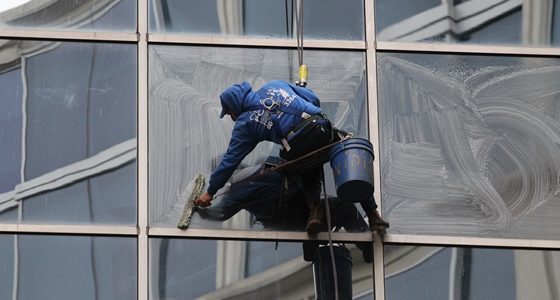
If your building's windows look streaky and/or dirty after they've been thoroughly washed, the issue may be more complex than you first thought. Unlike pollen, smoke, pollution, dirt or other surface substances, these stubborn whitish streaks could actually be caused by the substrate surrounding the window rather than an outside factor. Learn about what could be creating these problems for your building.
Efflorescence
One of the most common reasons for these unsightly marks is because the stone or concrete near your windows is filled with minerals and salts. When this material gets wet, the minerals or salts leach out of the concrete or the stone and rise to the surface.

Then, when it rains, minute particles of these salts or minerals deposit themselves on the glass window. As they dry, the substance that leached out can bond with the air and create an ugly efflorescence.
Efflorescence can be solved by a two-step approach of restoring the glass and preventing further problems. Clean and Polish Building Solutions can help you clean away the unsightly calcium oxide or salt stains from the windows as well as the concrete, brick or stone that surrounds them. Additionally, with specialty sealants this problem can be prevented going forward, keeping salts or mineral inside the building material never to leach out.
Silicate deposits
Silicate deposits are similar to efflorescence but they're much harder to clean, Applicator magazine explained. Unlike other salts or minerals, this issue starts when microscopic amounts of silicate are dissolved in the building material and wash onto the window's surface. These dissolved silicate particles are unique, and so difficult to clean, because they're negatively charged anions.
"Silicate deposits are difficult, but not impossible to clean."
Being negatively charged, a silicate anion wants to bond to a substance that can help it become neutral. The particles wash onto the glass and when they dry they bond with the window to create an ugly stain. These stains only get worse with outside factors, the magazine noted.
"These silicate deposits when coupled with atmospheric pollutants for a conglomeration that becomes a window-cleaning nightmare," Applicator explained.
Clean and Polish Building Solutions uses specially designed cleaning techniques to restore your building's glass to protect its appearance and function. Preventing further silicate deposits from developing requires different defenses than what you'd use against efflorescence.
Hard water and acid rain
Sometimes the minerals and salt that can create ugly oxidation on your windows isn't from the building itself, but rather the water. Windows that get sprayed with sprinklers or ground water can get minerals delivered directly to the glass, where it can streak, spot and stain.
Additionally, buildings in areas where acid rain is a problem can experience similar issues, where the water hitting the window is delivering the pollutant to the glass. The metal bordering a window can also lead to oxidation stains in some cases. No matter the reason your windows get dirty, Clean and Polish can help you determine the cause, restore your glass and apply the proper defenses.


